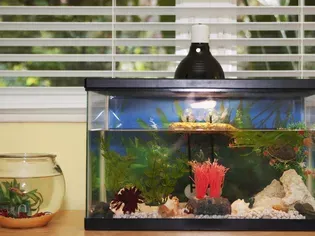Convert a Freshwater Aquarium to Saltwater Aquarium
Updated on 04/26/24

Embark on an Aquatic Odyssey: Converting Your Freshwater Haven into a Saltwater Sanctuary
Are you ready to embark on an exciting journey, transforming your tranquil freshwater aquarium into a vibrant saltwater paradise? This comprehensive guide will empower you with the knowledge and confidence to make this transition effortlessly. With meticulous attention to detail and a passion for aquatic wonders, we will delve into the fascinating world of converting a freshwater aquarium into a thriving saltwater haven.
Understanding the Differences: Freshwater vs. Saltwater Aquariums
Before embarking on this transformative endeavor, it's essential to grasp the fundamental differences between freshwater and saltwater aquariums. These variations will guide your conversion process and ensure a successful outcome for your aquatic inhabitants.
* Water Salinity: As the name suggests, a saltwater aquarium simulates the natural ocean environment with water that contains dissolved salts. The salinity level is measured in parts per thousand (ppt), typically ranging from 30 to 35 ppt, mimicking the salinity of seawater. In contrast, freshwater aquariums have negligible salt content, typically below 1 ppt.
* pH Level: The pH level, which measures water acidity, differs between freshwater and saltwater aquariums. Freshwater aquariums typically maintain a neutral pH of around 7.0, while saltwater aquariums have a slightly alkaline pH ranging from 8.1 to 8.4.
* Biological Filtration: Saltwater and freshwater aquariums employ different types of biological filtration. In freshwater aquariums, nitrifying bacteria convert ammonia and nitrite into nitrate, the least toxic form of nitrogen waste. In saltwater aquariums, a more complex process called "nitrogen cycling" occurs, involving nitrifying bacteria and other microorganisms that convert ammonia to nitrate and then further reduce it to nitrogen gas, which is released into the atmosphere.
Step-by-Step Guide to Convert Your Aquarium
Now that you understand the key differences, let's embark on the step-by-step conversion process:
* Prepare Your Aquarium: Remove all freshwater inhabitants, décor, and plants. Thoroughly clean the aquarium, filter, and equipment using saltwater to remove any residual freshwater.
* Introduce Artificial Saltwater: Gradually add artificial saltwater mix to your aquarium, following the manufacturer's instructions. Use a refractometer to ensure accurate salinity levels. Gradually increase the salinity over several days to avoid shocking your future saltwater inhabitants.
* Establish Nitrogen Cycling: Before adding any marine life, establish the nitrogen cycle in your saltwater aquarium. Introduce live rock or live sand, which contain beneficial bacteria, and perform regular water changes to remove excess ammonia and nitrite. The nitrogen cycle takes several weeks to stabilize, so be patient and monitor water parameters regularly.
* Choose Compatible Species: Carefully select saltwater species that are compatible with each other and suitable for the size of your aquarium. Consider factors like water quality, aggression levels, and feeding habits to ensure a harmonious underwater community.
* Provide Adequate Hiding Places: Saltwater fish and invertebrates need hiding places to feel secure and reduce stress. Introduce live rock, PVC pipes, or artificial caves to create a natural-looking and comfortable environment.
* Install Proper Lighting and Circulation: Saltwater corals and other photosynthetic organisms require specific lighting conditions to thrive. Invest in appropriate lighting fixtures and ensure adequate water circulation to provide oxygen and remove waste.
* Regular Maintenance: Saltwater aquariums require regular maintenance to maintain water quality and ensure the health of your inhabitants. Perform weekly water changes, clean the filter, and monitor water parameters such as salinity, pH, and nitrate levels.
Examples of Successful Conversions
To inspire you further, let's explore some successful examples of freshwater aquarium conversions to saltwater havens:
* Project: Freshwater to Reef Tank: A 55-gallon freshwater aquarium was meticulously converted into a thriving reef tank, showcasing a vibrant array of corals, anemones, and reef-dwelling fish.
* Project: Community to Saltwater Predator Tank: A 75-gallon community aquarium was transformed into a saltwater predator tank, featuring apex predators like sharks and rays, alongside a diverse supporting cast of fish and invertebrates.
* Project: Planted to FOWLR Tank: A heavily planted 40-gallon freshwater aquarium was successfully converted into a fish-only with live rock (FOWLR) tank, featuring a variety of colorful fish and live rock teeming with marine life.
Conclusion
Converting a freshwater aquarium to a saltwater wonderland is a rewarding and enriching experience. By following the comprehensive guide outlined in this blog, you can create a thriving ecosystem that captivates the senses and brings the beauty of the ocean into your home. Remember, patience, research, and attention to detail are key to a successful conversion. Embrace the challenge, and may your saltwater aquarium journey be filled with endless fascination and joy!
Explore More Pets

Freshwater Aquarium Filters
How to Deal With Cloudy Aquarium Water

Saltwater Aquarium Filters
How Do You Remove Chloramines From Tap Water?

Freshwater Aquariums & Habitat
Can I Keep My Koi Fish Inside?

Saltwater Aquariums & Habitat
14 Best Floating Plants for Your Aquarium

Freshwater Fish Health
How to Treat Ich on Freshwater Fish

Saltwater Fish Health
Fin Rot in Aquarium Fish

Freshwater Aquarium Filters
How to Do Aquarium Water Changes

Saltwater Fish Health
How Do Fish Get Parasites?